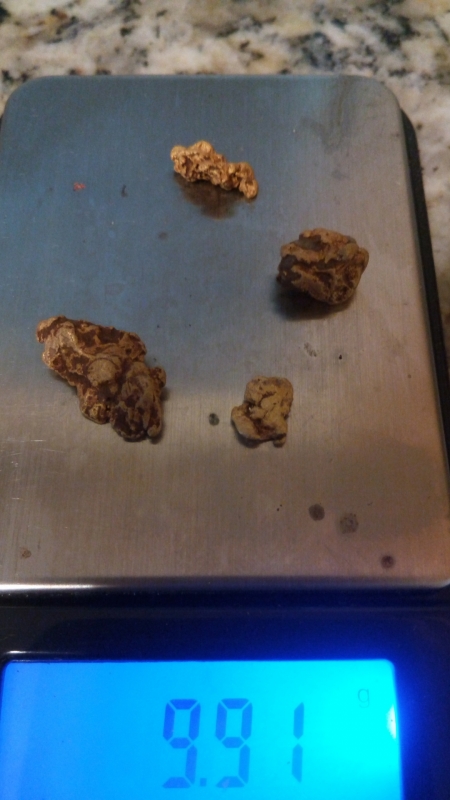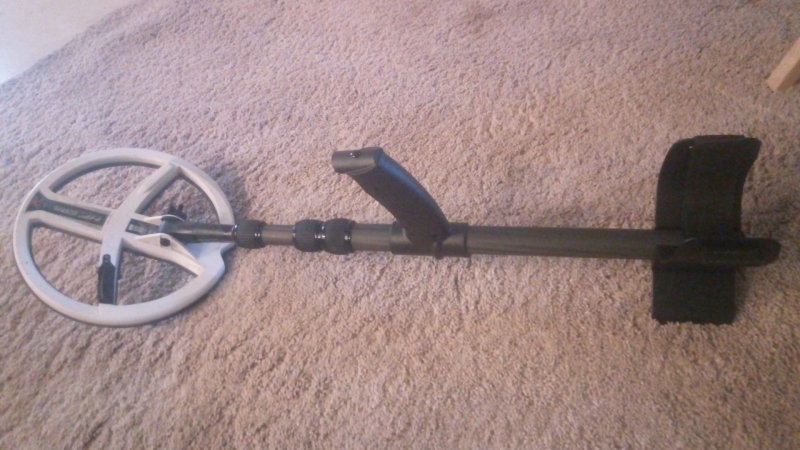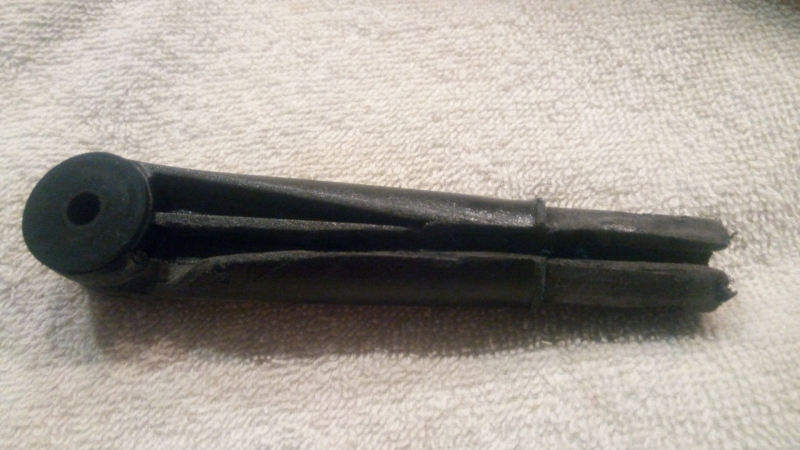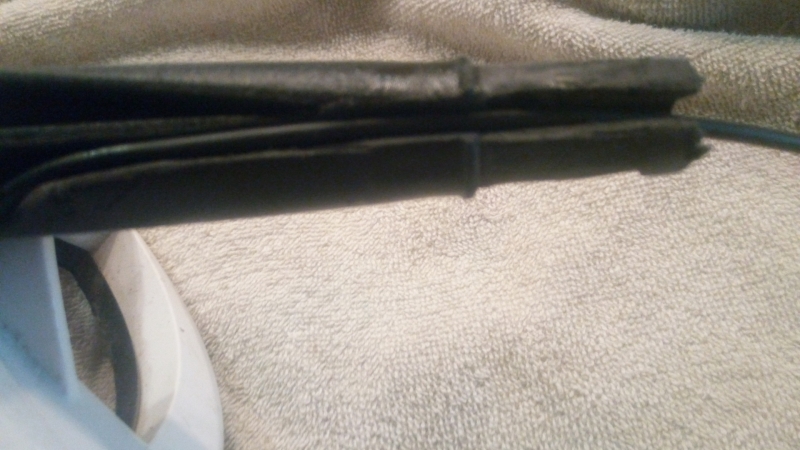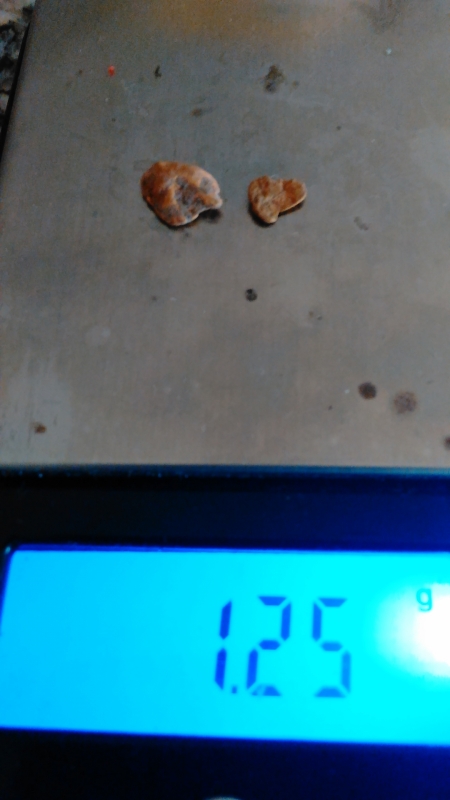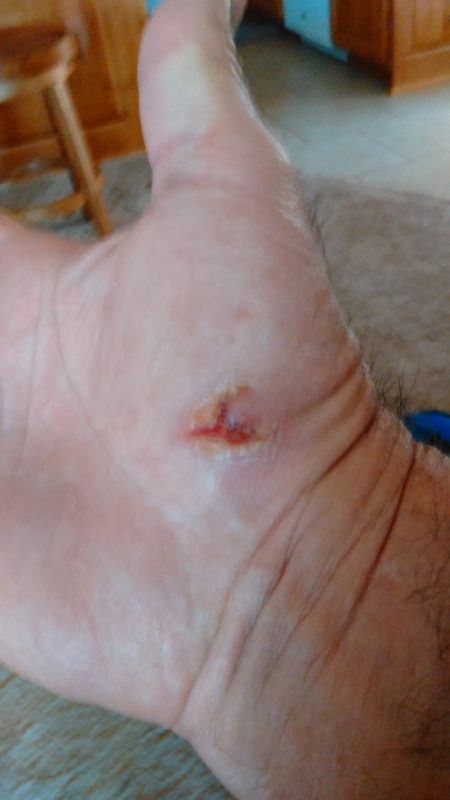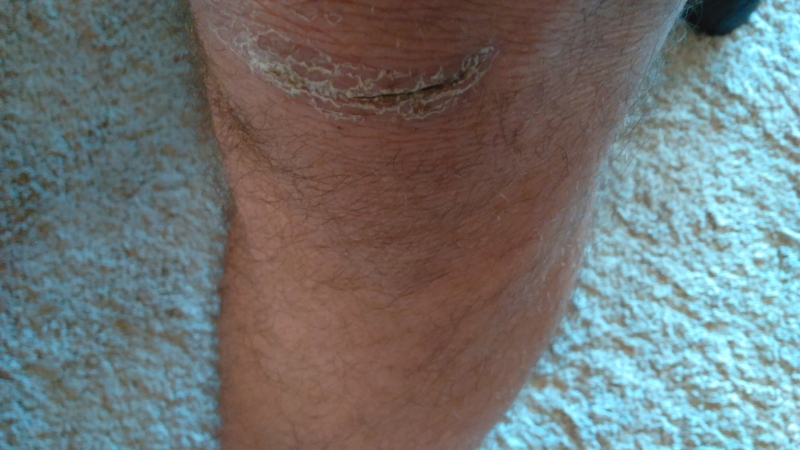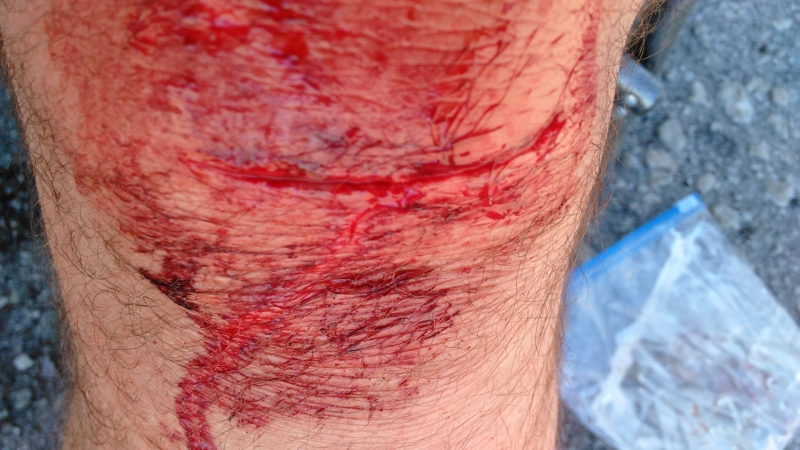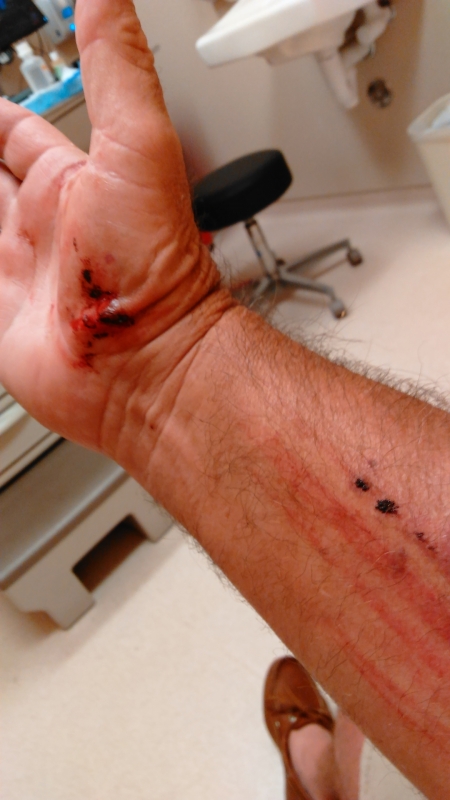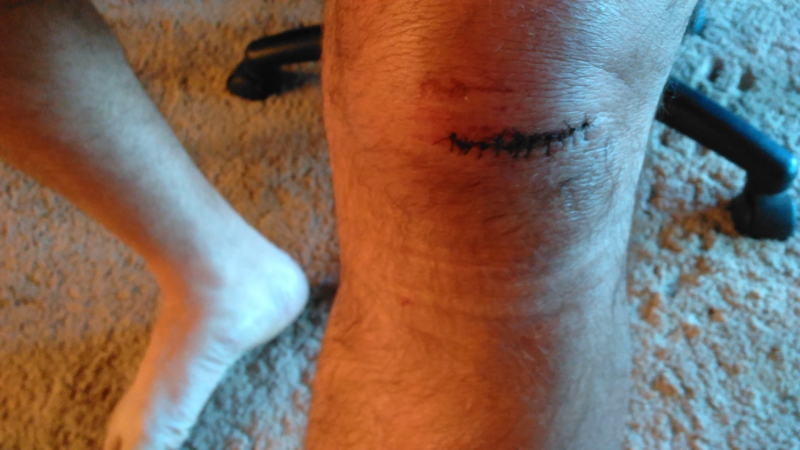
Condor
Full Member-
Posts
434 -
Joined
-
Last visited
Content Type
Forums
Detector Prospector Home
Detector Database
Downloads
Everything posted by Condor
-
New Wireless Headphones By Minelab
Condor replied to Goldseeker5000's topic in Minelab Metal Detectors
Can't say I'm surprised, a quality reviewer with a fair and balanced approach. Bravo Zulu -
New Wireless Headphones By Minelab
Condor replied to Goldseeker5000's topic in Minelab Metal Detectors
Wait a minute! Did Steve just admit he's testing the NOX? -
Greetings from sunny Yuma. The temps have just started to drop, still reaching high 80's by 11 AM, but the mornings are cool enough for a bit of detecting. I've been out for about 12 hrs total over the past week. We had just enough rain last month from a MicroBurst storm over parts of the placer areas here close to town. I found a couple washes where the big rocks had moved around a little giving me a chance to put the GPZ coil over some ground that might not have received good coil coverage last year. It paid off handsomely so far. I'm running my GPZ with HY, Normal, Sens 17, no threshold and using my old Etymotic in-ear monitors (earbuds). I'm looking forward to cooler temps and longer detecting days. Hey Beatup, you and Eric better hurry down here before I get all the gold. I don't know how we'll manage without NursePaul for comic relief.
-
It's a mere 114 degrees here in the Desert Southwest and I've got another bunged up knee. No stitches this time, just a bruise on the critical moving parts, but it gave me an opportunity to futz with my Deus conversion to the collapsible Golden Mask rod. The problem with the Deus HF coils is that the battery is stored in the rod tube, so you have a critical wire lead from the battery to the coil. Deus solved it by making the rod connection to the coil ears a hollow split design so that the battery wire runs straight up the rod with a curly wire section that acts like a spring to keep the wire under tension. The Golden Mask rod has a solid tip at the connection to the coil ears with no place to run the battery wire of the new Deus design. So, I got out the saw and the Dremel and started making some modifications. The first thing I had to do was cut off the Golden Mask solid connection tip that bolts to the coil ears. The tip is solid HD plastic that inserts into the carbon fiber hollow tube about 2 inches. So, I cut the carbon fiber above the insert so that I could reuse the insert. I then used the Dremel to cut a slotted path for the coil battery wire to run from the bottom of the coil ear connection insert with sufficient clearance for the wire to slide smoothly. The portion of the coil ear connection that inserts into the carbon fiber tube is more or less hollow, so I continued my wire path through the outer wall into the hollow section. That way, I could run the coil wire through the groove, then slide the wire inside the tip connection and when I re-inserted the tip section the whole mess is captured inside the tube, very close to the Deus type design. The battery pack fits squarely inside the 2nd segment of the Golden Mask collapsible tube with just enough tension to keep the wire sliding freely. I then put some black electrical tape around my grooved section to keep the wire firmly inside the groove. The only other thing was a rubber washer 5/16 X 3/4 from Lowe's hardware to shim up the coil ear connections for a tighter fit. What I end up with is a detector that weights less than 2 lbs, collapses to 24 inches and extends to a maximum of 51 inches. My goal has always been to make the Deus into a discriminating pinpointer to augment the Minelab 7000. Some of my Baja prospecting excursions have resulted in way too many deep holes to recover ferrous trash that falls off the turn of the century type drywashers the oldtimers used down there. At my age, it's all about conservation of energy. You can only dig so many 2 ft holes in 85 degree temps before your day is used up. If my new discriminating pinpointer can cut my digging time in half, I'll be thrilled. By way, I had the opportunity to compare the Deus side by side with the Gold Monster on undug targets in N. NV. I was certainly impressed with the GM target audio responses and its ability to quickly adjust to changing conditions. If I were starting out gold prospecting and could only afford VLF, I'd certainly make it the GM. I like my Deus as a supplement to my Z7000, but it is not a turn on and go machine. I think at the end of the day, GM users would cover more ground simply because it's so simple and target responses are unmistakable.
-
He's going to need isolation and decontamination when he returns. I hope he can stay with Scott this winter.
-
Hey Paul, I don't see a check for a WA woman. Maybe your preferences have been modified, you never know
-
All I know is one of the videos, testing the various Deus functions, showed a significant depth loss by adding too much silencer. I have only used mine for gold prospecting, but I always adjust to 0 just in case. My own testing has been relatively sparse using the 9" HF coil on gold nuggets.
-
Thoughts, Deus 9" Hf Vs Gm 1000?
Condor replied to 1515Art's topic in Metal Detector Advice & Comparisons
As Steve and others have pointed out, the GM is really a turn on and go. Obviously, it's fully capable of finding small gold. The XP Deus has a multitude of adjustments that I'm just now learning, but I'm quite confident it will keep up with the GM in the hands of a knowledgeable user, especially after the new elliptical coil arrives. I just don't think it will be the machine for a casual user who doesn't take the time to learn its various and, at first glance, complicated options. My testing a couple weeks ago with a .25 gram nugget really opened my eyes to the Deus possibilities. Way more performance tweeks to be explored. Naturally, I've got my share of confirmation bias since I already own the Deus and really want to believe in it. It's not my primary detector, but I'm anxious to work with those tweeks and squeeze some more performance out of it. It's all in what you want out of your secondary detector. Ease of use, pick it up and go with confidence that you're getting a good share of the detectable small gold, then the GM is the answer. If you're like me and need to fiddle with stuff thinking you're improving your odds, then the machine with more user control options makes sense. The key selling point for me was the packability of the Deus. I want to collapse that machine and stick it in my backpack just in case I run into small gold terrain while running my main machine the GPZ. -
What's the good word on NursePaul in OZ? You didn't use him for Croc bait did you? Post some pictures of all the gold he has recovered from your secret spots.
-
Some Thoughts On XP Deus Pricing & Configuration
Condor replied to Condor's topic in XP Metal Detectors
It is an expensive piece of equipment for sure. Although I haven't put the stock "Goldfield" program through its paces, in my limited use I was not particularly impressed and other than complete wireless operation, it wouldn't have any particular advantage over the existing gold detectors. I really like the idea of the wireless master controller and its "expert" menus. After some more study on the issue of Discrimination and Notch, I'm leaning towards the 4 tone program, with negative Discrimination then extreme low tones, one for ferrous and another for hot rocks. A much higher "sweet" tone for everything else. I'm anxious to try it out, but I'll have to wait till I get up there. I think those 120 degree temps in Yuma will decidedly temper my enthusiasm for VLF detecting in the desert Southwest. -
I've been bored on my dog sitting endeavor, so I've studied up on the Deus, and looked at a history of used sales. At least in the near term, it doesn't look like the Deus will be available in a strictly High Frequency model. So you're stuck buying the whole kit and then adding the HF coil. Retail for the whole kit is $1520.00 and then another $400.00 for the HF coil. The $1520.00 kit includes the wireless backphones and the main controller. The "puck" on the backphones can be removed and used as a standalone controller, albeit without the "expert" menus. Personally, I see no need for the backphones, the main wireless controller is really all you need and has all the "expert" menus. I've looked at buying the components individually, but you still end up paying dearly. The controller retails for $800.00, used ones on Ebay are roughly $500.00. The original (non HF) black 9" coil, retails for close to $500.00, used ones sell in the range of $300.00. The backphones retail for over $300.00, used ones sell for $200.00. A used Deus kit with backphone and controller sells for somewhere between $1000.00 and $1200.00, not very many are available though and they get snapped up quick. Rob at Rob's Detectors has a very lightly used one for sale at a good price, you'd have to check with him on actual price and shipping. So, if you assembled a Deus HF detector from components at retail, you'd spend roughly $1500.00. If you bought used rod/shaft, and controller, with a new HF coil, you're looking at just over $1000.00. Or,you could buy the whole kit and sell off the components you don't need. Better still, you get the whole kit, add a new shaft/rod assembly and end up with two detectors, one equipped with the "puck", the other with the main controller. Just random thoughts from a bored dog sitter. I'm in S. Cal right now, but sunny Yuma by the Sea will see temps of 118 to 120 this week. I'll get home just in time the catch those max temps, sweet!
-
I'm sure running the Reactivity up to 3 would have quieted the ground and on coin sized targets, you wouldn't be sacrificing much overall performance. It has been said that raising the Reactivity tends to shrink your coil coverage footprint. I don't know to what extent that occurs, but on tiny gold nuggets I'm looking to get all the performance I can out of a detector that was originally designed for coin, jewelry and relic hunting. My primary detector will always be the Z7000, but there are times when I would like to jump out and check some exposed bedrock or old tailings piles without the whole suiting up with the Zed. My other primary purpose for the Deus is to use it as a discriminating pinpointer when chasing deep targets with the Zed. This last year detecting in Baja involved far too much digging deep trash in hot weather. It really cuts down the number of productive detecting hours when you burn out on the first 5 or 6 deep holes. I found myself looking for reasons not to dig obviously deep targets. I guess my point is I'm looking at a better mousetrap, for some pretty narrow circumstances. The Deus is attractive to me because of its overall weight and collapsible enough to fit in my pack for 3/4 day hikes in rough terrain. And, if I ever get excited about coin/relic hunting I have the perfect machine for the job. I imagine once the Deus Elliptical coil comes out, we'll see some good comparisons and side by side testing by guys a whole lot smarter than me on this stuff.
-
We had a cold snap in sunny Yuma, low 70's at sunup. Didn't reach 80 till nearly 9am. I took the Deus out for a little testing in an area we have absolutely hammered with every known detector. I didn't find any gold, but the Deus surprised me with some of its capabilities. Per our discussion on the Notch vs. Discrimination theory, I set up the machine for 3 tones, relying on tone discrimination rather than true Notch or Iron Discrimination. With the Deus software the first setpoint for Tone discrimination really becomes a null, so 3 tones becomes 2 tones. It's actually a little more complicated than that, but won't help us for this discussion. So, I set the first actual audio tone, (2nd notch) for iron ID of between 0 and 20, and made it as low an audio tone as was possible. The next Tone breakpoint takes over from an ID of 20, where the last one left off, and all out way out to the end of range in the '90s. That tone is our sweet tone, you can set it at any level your hearing prefers. During my previous outings over undug targets, gold ID'd in the mid '50s. If you recall my first outing with the new HF coil, I was underwhelmed with the audio. Over a test nugget at the time, I missed the dynamic "zip" audio of the Gold Bug II. I thought the Deus audio somewhat anemic at the time. That all changed for me today. Using the remote to access the menu functions, I upped the audio response to 6 from the preset of 4. Wow, what a difference. So much difference that the machine got a little "chattery" in some of the hotter ground. But I live by "chattery" using the Z7000, so I just went with it. I found half a dozen shotgun pellets that just screamed dig me, showing a VID between 55 and 60, the same as gold. I buried a .25 gram nugget in some of the hottest ground I could find. The machine clipped and chirped, but at about 5 inches, the audio over the nugget was bright and crisp. No mistaking that audio, everything I thought I missed about the GBII audio, was alive and well in the Deus. Over the same test nugget and same hot ground I played with the other settings. I was running Sens at 85 and upped it to 90. While the target sound was somewhat brighter, the resulting feedback from the ground would have negated it for practical use in the field. Steve H would find a way to run this machine maxed out, but for me less was better. Raising the Reactivity helped quiet the "chatteryness", but I wanted to run the machine as wide open as possible. I settled on a Reactivity of 2. I then played with the Discrimination over the same nugget in the same hole. I ran it from negative 6, to positive 10. I found no benefit in this ground to running max negative Discrim, but a sweet spot seemed to be around negative 3. The more positive discrimination above +6 starts to give the test nugget at 5 inch depth, a breaking audio, alternating from the Iron tone to a true gold tone. No bueno for real life field prospecting, although it would be enough to make you stop and investigate. The Deus has a separate control for Iron volume, but that is disabled when running negative Discrimination. So, my current working theory is running Discrimination at +1, setting the iron volume at 1, then using the (Low)Tone feature to handle the rest of ordinary Iron problems out to an ID of 20. I tried the Deus standard Goldfield Program over the same ground. It just didn't do it for me so I left off without really giving it a true workout. Maybe it works, but I wanted to fiddle with all the other features of this machine. I'm off to ranch sit, taking care of horses and dogs for the next week or so. No more moments of clarity with the Deus till I make up to CA gold country. I might make it out for some beach detecting, so who knows. Until then, keep er low and slow.
-
Awesome stuff Rick, I bet you wished you had some of your world famous "redneck eggrolls" as a treat for Rudy's outstanding effort. Bravo Zulu to all you boys
-
VLF Detectors- Discrimination Vs Notch
Condor replied to Condor's topic in Metal Detector Advice & Comparisons
Steve, I see your point on using a specific tone assigned to typical goldfield trash rather than true discrimination. Running zero or even negative discrimination then setting the range of typical goldfield ferrous trash to the lowest tolerable tone, gold and other non-ferrous come in at a user preference higher pitch tone. Sounds good in theory. A great place to try it would be that hydraulic pit we hiked summer before last. Hopefully we see the new elliptical coil before I leave for N. CA. My trip has been delayed for a couple weeks. I should be up that way by the end of June now. -
I know this topic has appeared off and on over the years, but I'd like to better understanding on the theory and principle of using one over the other, ie. depth, and target id and what compromises do I induce. The reason I ask is the new V4 for XP Deus has the ability to set a minus discrimination. It kills the ability to use the "horseshoe" screen for ferrous target ID, but VID numbers are tolerable. What theoretically happens if I set a negative discrimination, but use Notch to handle ordinary ferrous trash?
-
Hey Norv, He's hard to understand under the best of circumstances, even for us. He comes from a part of the country where they have people who are their own uncle.
-
Monster Getting Banged By At Least One Aussie, Already
Condor replied to Condor's topic in Minelab Metal Detectors
In retrospect, Steve should probably close this topic. I don't think any good can come from a topic about "bashing" Minelab, it goes against the grain of this forum. Keep it real, keep it current and keep it tasteful. I want to read real world tests without some preconceived notion of the adverse outcome. My bad! -
I just read one report by an Aussie dissatisfied customer. What a surprise. We heard the same things about the initial release of the SDC 2300 and the GPZ 7000. As I recall our moderator took a fair amount of bashing from his reviews of the previous machines as well. For Pete's sake, it's a VLF and in OZ it cannot hope to equal pulse induction in hot ground, nor does it claim to. It's an entry level machine ostensibly targeting the African gold rush. Its price point and turn on and go features have a place. As Steve as said time and again, when considering VLF, there really are no groundbreaking technology innovations available for this platform other than ergonomics and simplicity of use. I've tried my hand at VLFs over the years and I liked the Gold Bug II for a very narrow purpose, small, shallow gold in relatively quiet ground. I sold it in favor of the Deus. I don't think the Deus, at least the 54Khz 9" round, is better than or even equal to the GBII for that purpose, but it is more versatile and I'm sticking with it. Get ready for the Minelab bashing to begin.
-
Hey Brett, They'll be there, ordinary flatlanders would need a helicopter to get to that spot. The only roads were washed in the late '50s. I'm pretty sure I'm the only modern detector ever been in there, but it really is the fringe of placer gold country. The area produced a lot of lead and silver, gold as a by-product. I have to keep thinking I'm going to find that isolated ledge of gold, it's not the probabilities, but the possibilities that keeps me going, plus I need the adventure.
-
OK, after all the kind words and get well wishes from my incautious adventuring on Outing IV, I went back out in the wilds of Sunny Yuma. Stitches out, hand still sore, groin injury tolerable. I left for the local Colorado River area on Wed afternoon to catch a few sundown largemouth bass with plans to hike what passes for mountains down here on Thur morning. Bass fishing was great, but I just couldn't get comfortable in a kayak with a bum knee and aching hamstring. I persevered and caught a couple nice bass. I slept on the boat, not the kayak mind you, and started hiking at sunup. I set the Deus HF up a little bit different thinking there would be no trash. I used the standard "Fast" program but added "negative" Discrimination available in the V4 update, Sens at 85, Freq 54, Reactivity 2. Right away I hit a couple ferrous trash targets that easily registered between 2 and 4 on the VID. Both modern type nails but the VID was spot on. Next I hit an old .22 shell casing with a VID of 74. I then hit the first nugget, the smallest of the two. It showed a solid VID of 58 and weighs .28 gram. Great start for the morning. I then hit a few more ferrous targets registering in the 2 to 4 VID and I didn't bother to dig. Next came the bigger nugget just shy of 1 gram. It was probably 4 to 6 inches deep and showed a solid VID of 55. When I rounded the next bend in the wash I found a small section of old drywash tailings up on the shoulder of the wash. Full of 1950's era trash, nails, screws and wire, apparently the source of the trash in the wash. One thing fooled me though, a deep tobacco tin registering in the high 60's and mid 70's on the VID. By then 2 hrs on, it was getting hot, mid 80's temps and I had a long walk back. I decided to take a short-cut, over the top of the mountains. Rarely a good idea, especially with an already bum knee and sore hamstring. Nevertheless I packed the Deus in my pack and broke out the trekking poles for the hike. I ended up finding a decent Mountain Sheep trail that wound me through the hills and out to within a 1/2 mile of my destination. When I got home and unpacked my gear I realized that I am a "Maroon" (Nurse Paul/Nevada Chris saying) and had left the Deus Control Unit and Earphones laying on a rock ledge while I packed the pack for the trek back. So tomorrow I'm headed back out there, although I think I'll take the GPZ 7000 and look for some deeper nuggets. I think I'm really getting the hang of this Deus. There is no threshold and over hot ground it clips and chirps. I'm sure that would affect depth ultimately, but it does what is expected for discriminating the ferrous trash. I think, although I can't be certain, the "negative" Discrimination makes the targets much more reactive on the VID screen. The "Horseshoe" screen was useless at these settings, however the VID was quite helpful. This machine is not bump sensitive and weighs next to nothing, after dragging that Z around, no kidding. I'm sure the Minelab Monster is going to be a great unit, but I'm sticking with this Deus. It's ultimately packable and reasonably forgiving on its settings. A great addition for the kind of detecting I do. Until the next time kids, Condor out.
-
Thanks for all the kind words boys. There is a minor upside to this mishap. I broke down and bought myself a Kindle Paperwhite E reader to pass the time. A marvelous product for us shut-ins. You don't need a reading lamp and I can adjust the font so that reading glasses are unnecessary. I had cataract surgery this spring and while my distance vision is now extraordinary, the implants can't really correct for close up work. I have reading glasses scattered around the house, never where I need them. I have been enjoying the fabulous works of Patrick O'Brien, Lucky Jack Aubrey and Stephen Maturin series. Over the past 10 years I have read this series at least 3 times through and enjoy it more each time I read. I am packing my gear for an overnighter with a little largemouth bass fishing and minor gold prospecting on tap here on the Colorado River. I did an evening 1/2 mile walk with some discomfort in the stitched knee and tolerable pain in the groin strain. Fresh air and sunshine are sure to speed my recovery. By mid June I'll be heading up north to CA gold country and probably Rye Patch. Hopefully, I'll catch up with some of you then.
-
Last week we had a brief cooling spell in sunny Yuma so I took the opportunity to get out with the Deus again. I was scouting a new area wearing my typical Yuma attire, shorts and T-Shirt and had not yet put on my gear and most regrettably had not put on my knee pads. I was pushing up through some steep terrain with loose gravel and big rocks. I took a wrong step and had one of those slow motion thoughts about this not ending well. It seems that gravity has some fairly predictable adverse effects on short, chubby, 62 yr old detectorists traversing tricky ground. I made roughly 3 rotations on the way down, coming to rest against some nasty rocks. As I lay there gathering my wits and waiting for pain to alert me to any major injuries, I wondered, not for the first time, why I do this, especially all alone. Nevertheless, I picked myself up and found I was bleeding pretty good from a puncture in fat part of my right palm. Then, I felt a searing pain from my right hamstring across my butt cheek to my scotumus maximus. Not cut mind you, just internal wrenching. I assume that's what the NFL calls a "groin strain". So I hobbled to safety and set about to stop the bleeding in my palm. It was only then that I noticed my left knee bleeding pretty good as well. I got some wound wash and squirted the knee clean, muttering "that's going to leave a mark". Since I didn't have the services of our favorite medic VANursePaul, I figured I better let the professionals at this one. I had my son take me to Sunny Yuma Regional Medical Center ER. Fairly quick work, XRays all negative, hand, knee and hip. 10 stitches in the knee, a script for Vicodin and I was on my way in just over 2 hrs. I'm pretty sure you're not supposed to mix my favorite analgesic "Dago Red" with the Vicodin, but the words "alcohol my intensify effect" seemed to suggest otherwise. So, last night I removed the last of the stitches and the knee feels fine, if not a little tender. The palm wound is still really sore and the "groin strain" is a killer. I walked a 1/4 mile this morning on flat blacktop in my neighborhood and the hamstring feels like an ice pick punching through my butt cheek to my nether regions. I'm losing my mind being hobbled and not outside outsmarting some gold nuggets. We have a bit of a cooling trend over the next few days, highs in the low 90's, so I'll be back at it, albeit a little slower and a little more careful. Hopefully, good news later this week on the rescheduled outing 4 with the Deus HF. So until then, as Sgt Esterhaus on Hill Street Blues used to say, "let's be careful out there".
-
I'm pretty sure I can match that performance with a glass eye in a duck's anus. Just my opinion mind you, I wouldn't want to impugn the integrity of a fortune 500 company with a boatload of peer reviewed test results. Awhile back I was in a local prospecting shop and some "flatlander greenhorns" were discussing the various technologies available for gold prospecting. One turned to me announced that the $39.00 divining rods were the way to go, that the clerk of the store had found lots of gold with them. I simply asked why she was working here if it were that simple. All I heard were crickets, somewhere way out there in the distance. Might have been AZ mole crickets, ugly scoundrels they are, nevertheless with all the available information not only here, but the entire web, how does anyone not know this stuff. No offense intended for all owners of "magnetic bracelets", "Long Range Locators" and "Skin so Soft" insect repellent. No sh**t, that stuff works.
-
Jasong, When I can get a good VDI, they range from mid 40 to mid 50's at 54KHZ. The tiny nuggets produce a good clear tone, but they will hardly register a VDI. I didn't show the backsides of a couple nuggets. Clearly specimen type nuggets.

